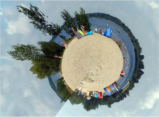Tiny Planet
With the Tiny Planet effect you distort a picture or video into a circular form. The x-coordinate of each pixel is transformed into the angle, the y-coordinate into a radial distance. The result is a sphere that looks like a little planet photographed from above using a fisheye lens.
The results you achieve with this effect strongly depend on the source image or video, so consider some rules:
- To achieve a seamless sphere the left and right borders should match as perfectly as possible. The ideal source would be a 360° video or panorama picture but you can achieve interesting effects on any video or image. With more narrow angles you might have to do some retouching to match textures and colors at the borders.
- The upper area of the picture will be heavily distorted, so so try not to have important material there. A clear blue sky works best.
- The same holds for the bottom, it will be squashed into a tiny area, so make sure there is a simple texture like a flat color, sand, or water.
- A straight horizon enables the picture edges to meet perfectly.
- Good source images are therefore: mountains, beaches, city skylines, city squares
IMPORTANT Panorama pictures usually are much wider than high. If you load them into a project with the usual 16:9 aspect ratio, black bars are added at the top and bottom of the picture which are included in the effect, resulting in a black hole in the middle of the planet and a perfectly circular black space around it. If you don't want this, right click the event and choose Properties. Deactivate Maintain aspect ratio to force the picture into the project aspect ratio, avoiding the black bars.

Original panorama photo

Tiny Planet from the photo
|
Item |
Description |
|---|---|
|
Latitude |
This value defines the position of the floor in the picture. Experiment with it. For pictures with non-matching borders, if you change it you get a different perspective on the planet, not straight from above any more. In combination with the Z value you can avoid displaying these areas. A value of 180° gives you a "hollow earth" perspective. |
|
Longitude |
This defines the angle of the left border of the image, in other words, which part of the picture should point up. You can also use this in combination with an envelope to rotate your tiny planet. |
|
Z |
Zoom value, controls the distance of your planet from the viewer. |